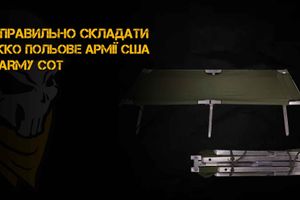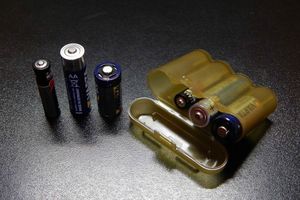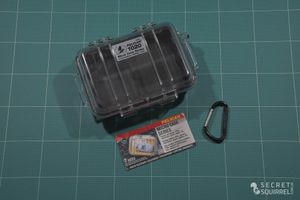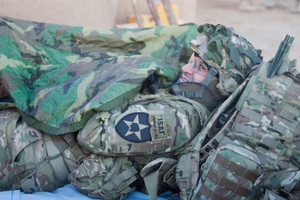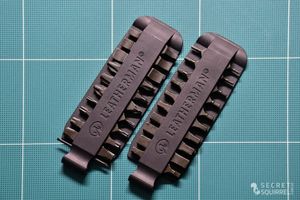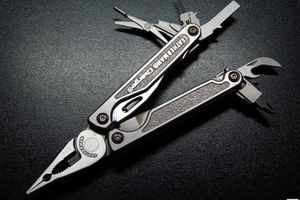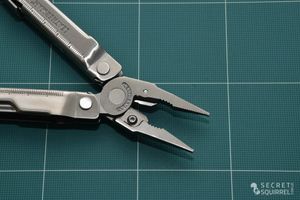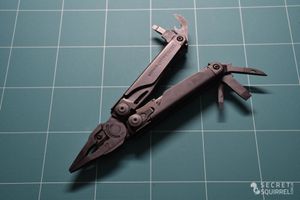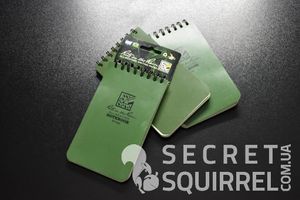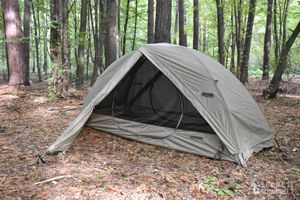Modular Sleep System (MSS) is an all-weather multi-component sleep system developed by Tennier Industries Inc., an American company that has been supplying sleeping bags and clothing for the US Armed Forces for over 30 years.
If you look at any report on the life of US soldiers at the advanced bases that have been shot over the past two decades, I’m sure that almost every of them will flash the Modular Sleep System (MSS) or its elements. The whole reason is that this is the main contracted sleeping system supplied by Tennier Industries Inc. to all military branches as part of defense orders.
The main reason why the Modular Sleep System (MSS) has become so widespread is that it is a multi-component modular system rather than a single bag. This solution can significantly facilitate logistics when sending a large number of troops to the place of service, because each of them is given one nomenclature position, using the elements of which further each fighter can effectively adapt to the climatic conditions of the place of departure, whether it be the tropics or the Arctic latitudes.
In the couple of decades that the Modular Sleep System (MSS) is in operation, it has already undergone several iterative cycles of improvements. The first was a 4-component system of three sleeping bags and one shipping cover, using layers in Black, Green colors and woodland camouflage, actual at that time. A little later, another compression cover was added to the system, and the color scheme of the layers was changed to Foliage and Universal Camouflage Pattern (UCP), resulting in a 5-component Modular Sleep System (MSS). And although both of them, at the time of writing, can be considered obsolete, their ratio of insulating qualities to weight, quality materials, and undeniable durability still remain relevant. Partly for this reason, MSS systems are still widely represented on the market for decommissioned military equipment (Military Surplus), and are used by outdoor enthusiasts around the world.
- Independent shelter that does not require the use of tents or tents.
- Four-component system: 3 sleeping bags and a shipping cover.
- Application in a wide temperature range from - 17 to +30 degrees Celsius, and in conjunction with the multi-layer clothing system Extended Cold Weather Clothing System (ECWCS) up to -35 to + 30 degrees Celsius.
- Main material: GORE-TEX, synthetic insulation Polarguard® High Void (HV) - (100% polyester).
- It is made in the USA.
Further in the review we will get acquainted with the Tennier Industries Modular Sleep System (MSS) in the version of 4 components and with the external bivouac in the color Woodland.
Black Stuff Sack
As befits any contracted outfit, the black case in which the other components of the Tennier Industries Modular Sleep System (MSS) are packaged has its own unique NATO Stock Number (NSN) # 8465-01-398-5428. The rest is a regular compression bag made of nylon, designed to protect system components from mechanical damage and moisture during transportation and storage.

At the lower end of the bag there is an impressive patch on which the product inventory number is indicated, and the contract number under which the bag was delivered to the US Armed Forces, as well as all instructions for caring for it. There is also a transport handle from an inch sling, overlapping the patch in the photo above.

The upper end of the transport bag is equipped with a pull-down neck, the position of which is fixed with a cord and a plastic cordlock. Inside the neck, a small valve is sewn from the main material of the bag, the task of which is to cover the contents while pulling the neck in order to protect it from moisture, precipitation, dirt and dust.

In total, the bag is equipped with nine compression slings made of an inch textile slings and YKK double-slotted buckles. Three such slings are located across the bag, and allow you to pull the contents in diameter. The remaining six lines are evenly distributed around the circumference of the bag and allow it to be pulled longitudinally.

By using this bag and compression slings, you can tighten the system components at least twice in relation to the original volume. Of course, the final result will strongly depend on the number of layers placed inside, as well as the time spent on stretching. Note also that the Modular Sleep System (MSS) layers inside the bag can be placed both in the coupled state and individually, which partly speeds up the process of loading / unloading the bag. So the layers you use the least, you can just leave inside the bag and not waste time unpacking them if you do not need them now.
Inside the compression bag are the following elements of the Modular Sleep System (MSS): an exterior protective bivouac in Woodland camouflage, a light sleeping bag in Green, and a warmed sleeping bag in Black, which I suggest to read further.
Woodland Camouflage Waterproof Bivy Cover

The external protective bivouac or Bivy Cover also has its own NSN # 8465-01-416-8517 for the standard version, and NSN # 8465-01-452-1695 for the version in the X-Long size. The care instructions are located on the tag located on the left side of the hood valve.

This is a regular Mummy Bag with a pronounced hood and flap that allows you to completely cover the user's face, thereby protecting it from the weather and insects.
This element is made of three layers of GORE-TEX material and has a camouflage Woodland top and Desert Tan underneath. This bivouac is designed to be 215 cm long. For protection against precipitation, moisture and wind, which allows you to protect the inner layers from the vicissitudes of the weather and mechanical damage.

At the user's right hand is a fairly large YKK zipper, opening the bag 3/4 of the length, and equipped with two double-sided runners, which allows you to open / close the bivouac being both outside and inside. To protect the zipper from dirt and dust, as well as from rain and moisture, the outer layer of the Modular Sleep System (MSS) is equipped with a special external valve that blocks the zipper.

Since the main task of this layer is to protect it from moisture and precipitation, all the seams on the inside of the bivouac are additionally glued with tape, which prevents water from seeping through small holes through which the seam thread is passed.

The upper neck of the hood on the outer layer of the Modular Sleep System (MSS) has a circumferential pull, for which an elastic sling with cordlock, brought out under the user's left hand, is responsible. The lower part of the neck does not tighten, because on it is the same valve that blocks the user's face.

When closed, the valve is fastened with two Velcro pieces placed on either side of the slot in the hood. When you sit inside the Modular Sleep System (MSS) bivouac and pull the hood, the Velcro on its outside will be in your forehead and the valve will cover your face completely, thereby blocking the path of rain and insects. True, one negative factor is also connected with this - the condensate from your breathing that accumulates on the inner surface of this valve with lowering temperatures. Since the material of the external bivouac is quite dense and has low vapor permeability, as a result, drops of condensate can drain back onto your face, which is not very pleasant during sleep. For this reason, I recommend that you leave the face protection valve not fully closed so that you have an air supply and the condensate has a vapor path. It would not be out of place to make this valve out of breathable mesh, but before that Tennier Industries Inc. came a little later in the Three Season Sleep System and TII Multi-Season Sleep System (TII M-SSS).
Camo Green Patrol Bag

Inside the protective bivouac, according to the manufacturer’s idea, a lightweight “summer” bag with NSN # 8465-01-398-0685 for the “standard” version and NSN # 8465-01-452-1688 for the X-long version are placed. Recommendations for caring for this layer are on the tag sewn outside in the area of the user's feet.

A “patrol” bag with a length of 230 cm and a shoulder width of about 92-94 cm inherits all the design features of the external bivouac: a protracted hood and a zipper 3/4 of the length of the bag located at the user's right hand. It got its name due to the fact that it is this layer of the Modular Sleep System (MSS) that the military most often places in their patrol backpacks when they enter short raids in climatic zones with hot and temperate climates, as By itself, it provides comfortable sleeping conditions in the temperature range from 0 to +20 degrees Celsius.
The outer layer of the bag is made of moderately dense nylon with reinforcement according to the Rip-Stop technology, inside which is a layer of Polarguard® High Void (HV) synthetic insulation.

The YKK zipper, like the external bivouac, has two double-sided runners, allowing you to open the bag from the outside and from the inside. For ease of use, the runners have long tacks of a flat thread.
In the photo above, you should also pay attention to the windproof bar with a heater located along the zipper along its entire length, designed to protect you from blowing the zipper, and the unpleasant sensations associated with it. From the side of the runners, the windproof bar is covered with a nylon sling, thanks to which the insulation does not clog between the teeth of the zipper, and thus does not prevent it from fastening.

At the neck of the bag, for additional fixation of the zipper in the closed state, there is a small velcro strap that covers the slider.

The neck of the bag, this time, is pulled together on both sides, for which an elastic with a cordlock is displayed, also brought out under the user's left hand. Using this elastic, you can evenly tighten the hood of the bag and the edge covering the shoulders, either simultaneously or separately, pulling the corresponding half of the elastic.
Black Intermediate Bag

The final element of the Modular Sleep System (MSS) is a warming, or so-called “intermediate” sleeping bag, which, according to the manufacturers' idea, is installed inside an easy sleeping bag and an outdoor bivouac. He also has his own NSN kit: NSN standard size # 8465-01-398-0687, X-Long elongated - NSN # 8465-01-452-1690. The care instructions are located on the tag located in the same place as the “patrol” bag, in the area of the feet.

This bag is 215 cm long, has an outer layer of nylon with Rip-Stop reinforcement, and is designed to warm the Modular Sleep System (MSS) kit in case of a cold snap. By itself, it can be used for overnight at temperatures from -15 to 0 degrees Celsius. Structurally, a “patrol” bag inherits: a “mummy” bag, a tightening hood and a 3/4 length zipper at the right hand.
Inside, the same Polarguard® High Void (HV) synthetic insulation is used as in a light bag, but its layer is significantly larger than the last. Because Since feet are most frozen at low temperatures, a double layer of insulation is used in the area of the legs near the black bag.

Lightning, like the previous bags, is moderately large, made by YKK, equipped with two double-sided runners with large tacks. Allows you to close \ open the bag both outside and inside.
Like a patrol bag, it has a windproof insert along the entire length of the zipper to prevent freezing through the section with the smallest material thickness.

A significant difference of this bag is the presence of an insulated “shelf” on the inner surface covering the shoulders and upper chest of the user. This shelf is intended for additional warming, as well as insulation in case you turn on your side or tighten the neck not completely.
In the upper part of the zipper there is also a Velcro strap that covers the slider and does not allow the zipper to unfasten itself if you spin inside the bag.

Like the Camo Green Patrol Bag, the neck of the insulated Modular Sleep System (MSS) bag is equipped with a double-sided elastic and cordlock tie, the halves of which can be fixed independently. This tightening allows you to more tightly press the insulated "shelf" to the user's chest, as well as tighten the hood of the bag in case of low temperatures.

As you already noticed, the only element for all Modular Sleep System (MSS) bags is a zipper in 3/4 of the length of the bags. On both sides of these zippers, at an equal distance from each other, there are two-way buttons that allow you to close the system layers together. Using these buttons you can configure Modular Sleep System (MSS) in the following ways:
- Woodland Camouflage Waterproof Bivy Cover as a separate shelter for high temperatures.
- Camo Green Patrol Bag as a separate shelter for moderate temperatures without precipitation.
- Black Intermediate Bag as a separate shelter for low temperatures without precipitation.
- Black Intermediate Bag + Camo Green Patrol Bag for extremely low temperatures without precipitation or wind.
- Camo Green Patrol Bag + Woodland Camouflage Waterproof Bivy Cover for moderate temperatures with precipitation or wind.
- Black Intermediate Bag + Woodland Camouflage Waterproof Bivy Cover for low temperatures with precipitation or wind.
- Black Intermediate Bag + Camo Green Patrol Bag + Woodland Camouflage Waterproof Bivy Cover for extremely low temperatures with precipitation or wind.
As you can see, only three layers included in the Modular Sleep System (MSS) allow you to get as many as seven cover options, providing you with wide adaptability to various temperature and situational conditions. Also, you do not have to transport all layers of the system at the same time, which will reduce the transferred weight and volume, and also provides you with high compatibility with other types of individual (such as Eureka TCOP or Litefighter 1 Individual Shelter System) and group shelters. In fairness, I also note the fact that the most flexible Modular Sleep System (MSS) will be in its entirety, but in most stores selling Military Surplus, it is also possible to purchase its components separately, which is very convenient in case of damage to one of the layers, or selection of the most relevant layers for you, taking into account climatic features or an affordable budget.
I would also recommend in conjunction with Modular Sleep System (MSS) to use several compression bags, selected for each layer. This will allow you to use only the layers that are relevant to you at the moment in isolation, without having to pack one external bivouac into a complete compressor, the dimensions and weight of which will be excessive for you.
We thank punisher.com.ua for the Tennier Industries Modular Sleep System (MSS) sample provided for review.













































































































































